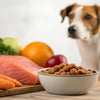Homemade Diet for Dogs with Colitis: A Comprehensive Guide
- Houndsy
Table of Contents
- Introduction
- Understanding Colitis in Dogs
- Why Homemade Diets?
- Key Components of a Homemade Diet for Dogs with Colitis
- Sample Homemade Diet Recipes for Dogs with Colitis
- Transitioning to a Homemade Diet
- Monitoring Your Dog's Health
- Conclusion
- FAQs
Introduction
Did you know that colitis affects a significant number of dogs, leading to distressing symptoms like diarrhea, abdominal pain, and even bloody stools? As pet owners, we often find ourselves in a position where we must navigate the complexities of our furry friends' health, especially when gastrointestinal issues arise. Colitis can be particularly challenging, as it often requires careful dietary management.
In this blog post, we will delve into the nuances of creating a homemade diet for dogs with colitis. We will explore the causes of this condition, what constitutes a suitable diet, and how to prepare meals that not only cater to your dog's specific health needs but also ensure they receive balanced nutrition. By the end of this article, you will have a comprehensive understanding of how to support your dog's digestive health through diet.
We're here to guide you through every step of this process, helping you to create a feeding routine that enhances your dog's overall well-being and aligns with their dietary needs. Let's embark on this journey together, ensuring our beloved pets receive the care they deserve.
Understanding Colitis in Dogs
Colitis refers to the inflammation of the colon, leading to various gastrointestinal symptoms. It can be classified into acute and chronic forms, with several potential causes:
- Infections: Bacterial, viral, or parasitic infections can lead to colitis.
- Dietary Sensitivities: Some dogs may have sensitivities or allergies to specific food ingredients.
- Stress: Emotional stress can exacerbate digestive issues.
- Inflammatory Bowel Disease (IBD): A more serious condition that involves chronic inflammation of the gastrointestinal tract.
Recognizing the signs of colitis is crucial. Symptoms often include:
- Frequent, small bowel movements
- Diarrhea, sometimes with blood or mucus
- Abdominal discomfort or pain
- Decreased appetite or weight loss
If your dog shows these symptoms, it's essential to consult your veterinarian for a proper diagnosis and treatment plan.
Why Homemade Diets?
While commercial diets are available specifically formulated for dogs with colitis, some pet owners prefer to prepare homemade meals for their dogs. Here are several reasons why a homemade diet can be beneficial:
- Control Over Ingredients: You can select high-quality ingredients that suit your dog's specific needs.
- Customization: Every dog is different, and a homemade diet allows for tailored nutrition, especially for those with food sensitivities.
- Freshness: Homemade meals can be fresher and more appealing than some commercial dog foods.
- Avoiding Fillers: Many commercial diets contain fillers or artificial additives that may not be ideal for your dog's digestive health.
Key Components of a Homemade Diet for Dogs with Colitis
When creating a homemade diet for dogs with colitis, it’s essential to focus on easily digestible ingredients. Here are key components to consider:
1. Lean Proteins
Opt for lean protein sources that are gentle on the digestive system. Good options include:
- Chicken: Skinless and boneless, ideally boiled or baked.
- Turkey: A great alternative that is low in fat.
- Fish: Options like salmon and tilapia provide omega-3 fatty acids, which can have anti-inflammatory properties.
2. Complex Carbohydrates
Carbohydrates provide energy and can help firm up stool. Consider:
- Sweet Potatoes: Rich in vitamins and easy to digest.
- Pumpkin: A great source of fiber and helps regulate digestion.
- Brown Rice: A gentle option for many dogs, though always ensure your dog tolerates it well.
3. Vegetables
Adding small amounts of cooked vegetables can provide essential nutrients. Good choices include:
- Carrots: Rich in vitamins and fiber.
- Green Beans: Low in calories and high in fiber.
- Spinach: Packed with vitamins, but should be given in moderation.
4. Healthy Fats
Incorporating healthy fats can support overall health, including skin and coat condition. Consider:
- Fish Oil: Provides omega-3 fatty acids.
- Flaxseed Oil: A good source of omega-3s and omega-6s.
5. Supplements
While homemade diets can be nutritious, they may lack certain vitamins and minerals. Consult your vet about appropriate supplements, such as:
- Probiotics: To promote healthy gut flora.
- Multivitamins: To ensure balanced nutrition.
Sample Homemade Diet Recipes for Dogs with Colitis
Here are a few simple recipes that can be easily prepared at home. Always consult with your veterinarian before making significant dietary changes.
Recipe 1: Chicken and Sweet Potato Diet
Ingredients:
- 3 ounces of boiled chicken (shredded)
- 6 ounces of cooked sweet potato (mashed)
- ½ teaspoon of fish oil
Instructions:
- Boil the chicken until fully cooked, then shred it.
- Cook the sweet potato until soft, then mash it.
- Mix the chicken and sweet potato together with fish oil.
- Serve in two meals throughout the day.
Recipe 2: Turkey and Pumpkin Diet
Ingredients:
- 3 ounces of ground turkey (cooked)
- 4 ounces of canned pumpkin (not the spiced pie filling)
- ½ teaspoon of flaxseed oil
Instructions:
- Cook the ground turkey until fully done.
- Mix with canned pumpkin and add flaxseed oil.
- Divide into two meals.
Recipe 3: Fish and Rice Diet
Ingredients:
- 3 ounces of baked tilapia (or another white fish)
- ½ cup of cooked brown rice
- ½ teaspoon of fish oil
Instructions:
- Bake the fish until cooked through, then flake it into pieces.
- Mix with brown rice and fish oil.
- Serve in two meals.
Transitioning to a Homemade Diet
Transitioning your dog to a homemade diet should be done gradually to minimize digestive upset. Follow these steps:
- Start Slow: Begin by mixing a small amount of the homemade diet with your dog's current food.
- Gradually Increase: Over 7-10 days, gradually increase the proportion of the homemade diet while decreasing the commercial food.
- Monitor Response: Keep an eye on your dog's stool quality, appetite, and overall behavior. Adjust the diet as needed based on their response.
Monitoring Your Dog's Health
Once your dog is on a homemade diet, it's essential to monitor their health closely. Look for any changes in:
- Stool Quality: It should be firm and well-formed.
- Appetite: Your dog should show interest in meals.
- Energy Levels: A happy, active dog is generally a sign of good health.
Regular check-ups with your veterinarian are crucial to ensure your dog is receiving adequate nutrition and to make any necessary adjustments to their diet.
Conclusion
Creating a homemade diet for dogs with colitis can significantly enhance their quality of life. By focusing on easily digestible ingredients, you can help alleviate their symptoms and provide them with the nutrition they need. Remember, the journey to a healthier dog is a collaborative effort—consult with your veterinarian to formulate a diet that works best for your furry friend.
If you're looking for a convenient and efficient way to manage your dog's feeding routine, consider exploring the Houndsy Kibble Dispenser. Designed with pet owners in mind, it combines aesthetics with functionality, making your dog's feeding time both enjoyable and stress-free.
FAQs
1. Can I feed my dog with colitis a raw diet?
Raw diets can be controversial, especially for dogs with colitis. It's essential to consult with your veterinarian before making this switch, as raw diets may not provide the balanced nutrition needed for dogs with digestive issues.
2. How long does it take for a homemade diet to show results?
You may start to see improvements in your dog's symptoms within 2-4 weeks after transitioning to a homemade diet. Monitor their response closely and consult your vet if symptoms persist.
3. Are there any foods I should avoid for dogs with colitis?
Yes, avoid fatty foods, dairy, and any ingredients your dog has previously reacted to. Also, be cautious with treats that may upset their digestive system.
4. How often should I feed my dog with colitis?
Feeding small, frequent meals can help manage colitis symptoms. Consider splitting their daily food intake into two or three smaller meals.
5. Should I use supplements for my dog with colitis?
Consult with your veterinarian regarding the use of probiotics or other supplements to support gut health. These can be beneficial but should be tailored to your dog's specific needs.













